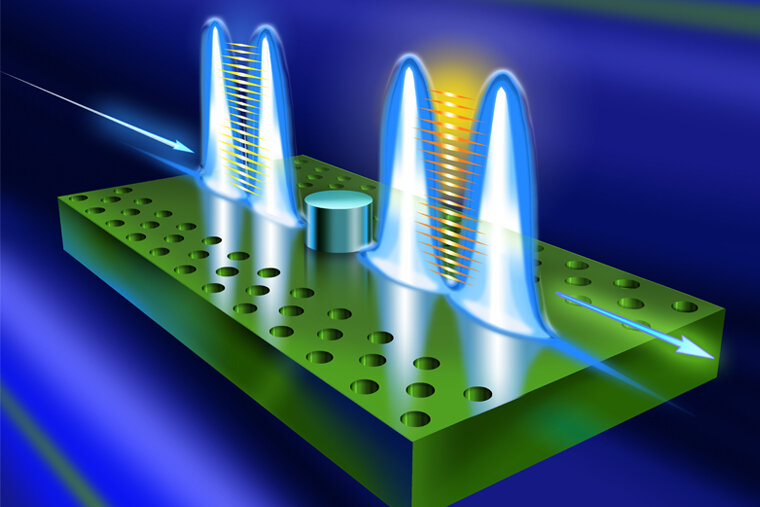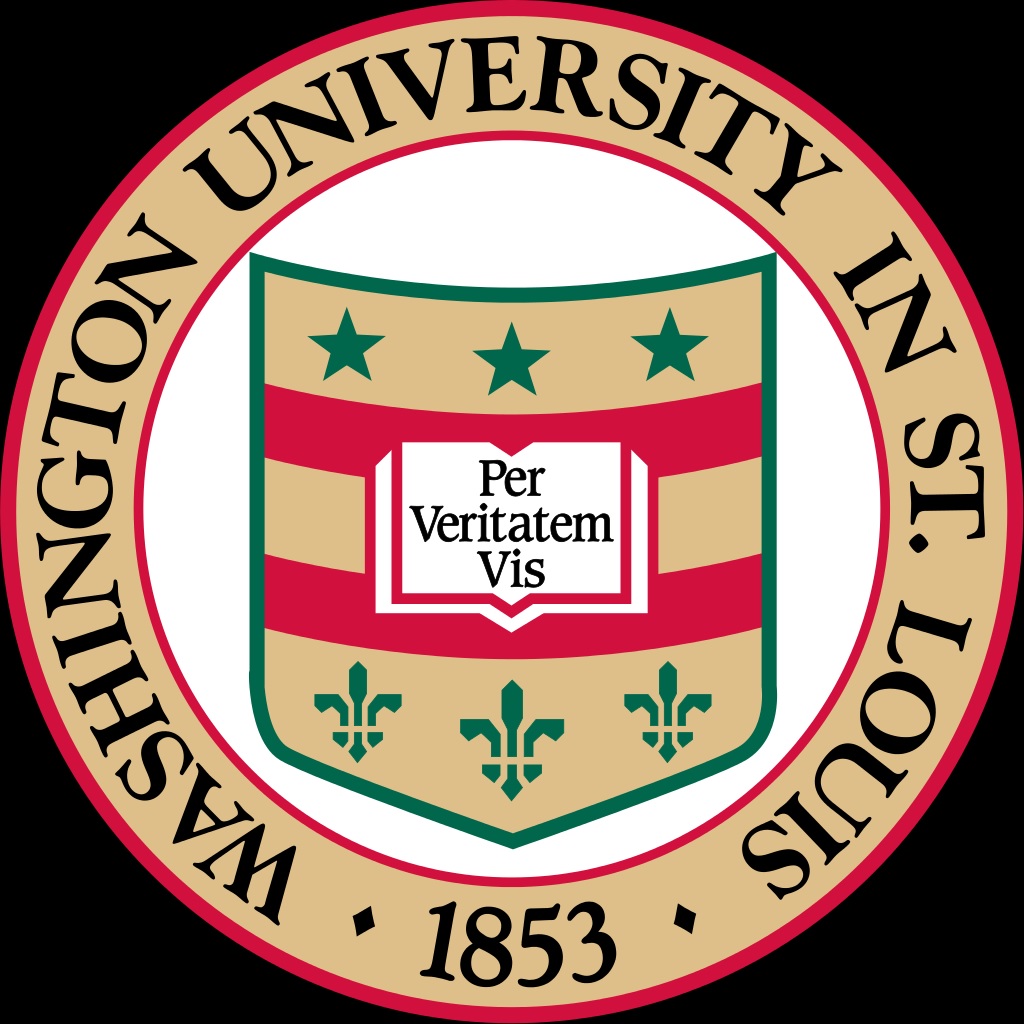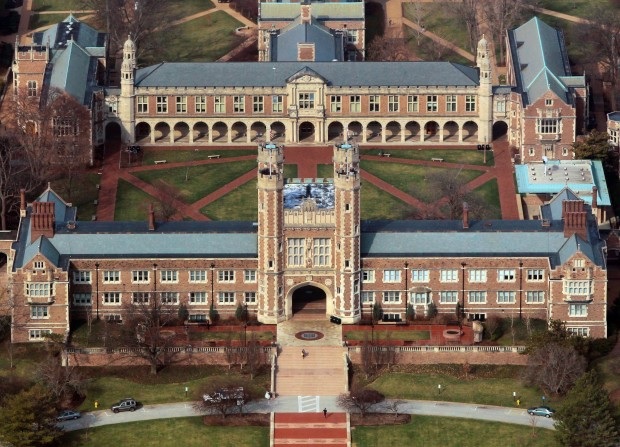From Washington University in St. Louis
June 28, 2021
Brandie Jefferson
brandie.jefferson@wustl.edu

Jung-Tsung Shen, associate professor in the Department of Electrical & Systems Engineering, has developed a deterministic, high-fidelity, two-bit quantum logic gate that takes advantage of a new form of light. This new logic gate is orders of magnitude more efficient than the current technology. Credit: Jung-Tsung Shen.
Research from the McKelvey School of Engineering at Washington University in St. Louis has found a missing piece in the puzzle of optical quantum computing.
Jung-Tsung Shen, associate professor in the Preston M. Green Department of Electrical & Systems Engineering, has developed a deterministic high-fidelity two-bit quantum logic gate that takes advantage of a new form of light. This new logic gate is orders of magnitude more efficient than the current technology.
“In the ideal case, the fidelity can be as high as 97%,” Shen said.
His research was published in May 2021 in the journal Physical Review A.
The potential of quantum computers is bound to the unusual properties of superposition-the ability of a quantum system to contain many distinct properties or states at the same time-and entanglement — two particles acting as if they are correlated in a non-classical manner, despite being physically removed from each other.
Where voltage determines the value of a bit (a 1 or a 0) in a classical computer, researchers often use individual electrons as “qubits,” the quantum equivalent. Electrons have several traits that suit them well to the task: they are easily manipulated by an electric or magnetic field and they interact with each other. Interaction is a benefit when you need two bits to be entangled — letting the wilderness of quantum mechanics manifest.
But their propensity to interact is also a problem. Everything from stray magnetic fields to power lines can influence electrons, making them hard to truly control.
For the past two decades, however, some scientists have been trying to use photons as qubits instead of electrons. “If computers are going to have a true impact, we need to look into creating the platform using light,” Shen said.
Photons have no charge, which can lead to the opposite problems: they do not interact with the environment like electrons, but they also do not interact with each other. It has also been challenging to engineer and to create ad hoc (effective) inter-photon interactions. Or so traditional thinking went.
Less than a decade ago, scientists working on this problem discovered that, even if they weren’t entangled as they entered a logic gate the act of measuring the two photons when they exited led them to behave as if they had been. The unique features of measurement are another wild manifestation of quantum mechanics.
“Quantum mechanics is not difficult, but it’s full of surprises,” Shen said.
The measurement discovery was groundbreaking, but not quite game-changing. That’s because for every 1,000,000 photons, only one pair became entangled. Researchers have since been more successful, but, Shen said, “It’s still not good enough for a computer,” which has to carry out millions to billions of operations per second.
Shen was able to build a two-bit quantum logic gate with such efficiency because of the discovery of a new class of quantum photonic states-photonic dimers-photons entangled in both space and frequency. His prediction of their existence was experimentally validated in 2013, and he has since been finding applications for this new form of light.
When a single photon enters a logic gate, nothing notable happens — it goes in and comes out. But when there are two photons, “That’s when we predicted the two can make a new state, photonic dimers. It turns out this new state is crucial.”

High-fidelity, two-bit logic gate, designed by Jung-Tsung Shen.
Mathematically there are many ways to design a logic gate for two-bit operations. These different designs are called equivalent. The specific logic gate that Shen and his research group designed is the controlled-phase gate (or controlled-Z gate). The principal function of the controlled-phase gate is that the two photons that come out are in the negative state of the two photons that went in.
“In classical circuits, there is no minus sign,” Shen said. “But in quantum computing, it turns out the minus sign exists and is crucial.”
When two independent photons (representing two optical qubits) enter the logic gate, “The design of the logic gate is such that the two photons can form a photonic dimer,” Shen said. “It turns out the new quantum photonic state is crucial as it enables the output state to have the correct sign that is essential to the optical logic operations.”
Shen has been working with the University of Michigan (US) to test his design, which is a solid-state logic gate — one that can operate under moderate conditions. So far, he says, results seem positive.
Shen says this result, while baffling to most, is clear as day to those in the know.
“It’s like a puzzle,” he said. “It may be complicated to do, but once it’s done, just by glancing at it, you will know it’s correct.”
This research was supported by the National Science Foundation (US).
See the full article here .
five-ways-keep-your-child-safe-school-shootings
Please help promote STEM in your local schools.
Washington University in St. Louis is a private research university in Greater St. Louis with its main campus (Danforth) mostly in unincorporated St. Louis County, Missouri, and Clayton, Missouri. It also has a West Campus in Clayton, North Campus in the West End neighborhood of St. Louis, Missouri, and Medical Campus in the Central West End neighborhood of St. Louis, Missouri.
Founded in 1853 and named after George Washington, the university has students and faculty from all 50 U.S. states and more than 120 countries. Washington University is composed of seven graduate and undergraduate schools that encompass a broad range of academic fields. To prevent confusion over its location, the Board of Trustees added the phrase “in St. Louis” in 1976. Washington University is a member of the Association of American Universities (US) and is classified among “R1: Doctoral Universities – Very high research activity”.
As of 2020, 25 Nobel laureates in economics, physiology and medicine, chemistry, and physics have been affiliated with Washington University, ten having done the major part of their pioneering research at the university. In 2019, Clarivate Analytics ranked Washington University 7th in the world for most cited researchers. The university also received the 4th highest amount of National Institutes of Health (US) medical research grants among medical schools in 2019.
Research
Virtually all faculty members at Washington University engage in academic research, offering opportunities for both undergraduate and graduate students across the university’s seven schools. Known for its interdisciplinary and departmental collaboration, many of Washington University’s research centers and institutes are collaborative efforts between many areas on campus. More than 60% of undergraduates are involved in faculty research across all areas; it is an institutional priority for undergraduates to be allowed to participate in advanced research. According to the Center for Measuring University Performance, it is considered to be one of the top 10 private research universities in the nation. A dedicated Office of Undergraduate Research is located on the Danforth Campus and serves as a resource to post research opportunities, advise students in finding appropriate positions matching their interests, publish undergraduate research journals, and award research grants to make it financially possible to perform research.
According to the National Science Foundation (US), Washington University spent $816 million on research and development in 2018, ranking it 27th in the nation. The university has over 150 National Institutes of Health funded inventions, with many of them licensed to private companies. Governmental agencies and non-profit foundations such as the NIH, Department of Defense (US), National Science Foundation, and National Aeronautics Space Agency (US) provide the majority of research grant funding, with Washington University being one of the top recipients in NIH grants from year-to-year. Nearly 80% of NIH grants to institutions in the state of Missouri went to Washington University alone in 2007. Washington University and its Medical School play a large part in the Human Genome Project, where it contributes approximately 25% of the finished sequence. The Genome Sequencing Center has decoded the genome of many animals, plants, and cellular organisms, including the platypus, chimpanzee, cat, and corn.
NASA hosts its Planetary Data System Geosciences Node on the campus of Washington University. Professors, students, and researchers have been heavily involved with many unmanned missions to Mars. Professor Raymond Arvidson has been deputy principal investigator of the Mars Exploration Rover mission and co-investigator of the Phoenix lander robotic arm.
Washington University professor Joseph Lowenstein, with the assistance of several undergraduate students, has been involved in editing, annotating, making a digital archive of the first publication of poet Edmund Spenser’s collective works in 100 years. A large grant from the National Endowment for the Humanities (US) has been given to support this ambitious project centralized at Washington University with support from other colleges in the United States.
In 2019, Folding@Home (US), a distributed computing project for performing molecular dynamics simulations of protein dynamics, was moved to Washington University School of Medicine from Stanford University (US). The project, currently led by Dr. Greg Bowman, uses the idle CPU time of personal computers owned by volunteers to conduct protein folding research. Folding@home’s research is primarily focused on biomedical problems such as Alzheimer’s disease, Cancer, Coronavirus disease 2019, and Ebola virus disease. In April 2020, Folding@home became the world’s first exaFLOP computing system with a peak performance of 1.5 exaflops, making it more than seven times faster than the world’s fastest supercomputer, Summit, and more powerful than the top 100 supercomputers in the world, combined.




